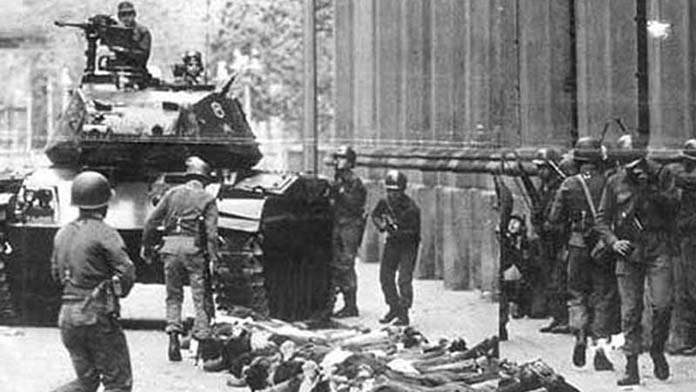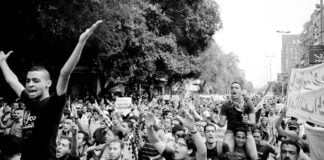In 1973 workers in Chile were on the march and could have taken power, but the left’s failures allowed the ruling class to unleash bloody repression, argues Raili Maria Haagensen
The 11 September was the date of a terrible disaster many years before the attack on the World Trade Center that also took place on 9/11. In Chile in 1973, a military coup led by Augusto Pinochet brought down the elected government of Salvador Allende.
By 9am, the presidential palace where Allende remained was surrounded by tanks, before being bombed by the air force. Within a couple hours, Allende and many of his top officials were already dead.
The military patrolled the streets shooting and rounding up opponents to be tortured, starved, abused and murdered. In the following 12 months 30,000 people were killed.
But it was not simply the Allende government but the scale of working class struggle that it had unleashed that the ruling class wanted to break.
Allende was elected in 1970 on a back of a massive wave of working class activity.
He represented a coalition of six parties called Popular Unity, the most important components of which were the Socialist Party, of which Allende was a member, and the Chilean Communist Party.
But despite claims that Chile had just elected its first “Marxist” president, Allende was no revolutionary.
The central features of his programme were to be wage increases to stimulate the economy, an Agrarian Reform Act taken over in its entirety from the previous Christian Democratic government, and most important of all, the nationalisation without compensation of the US-owned copper mines and a limited number of other companies, mostly foreign-owned.
In effect, the “Chilean Way to Socialism”, as it was sometimes called, was little more than a relatively orthodox Keynesian plan for boosting the economy, without any general challenge to the framework of capitalism.
But it was not the content of the policies itself that rattled the ruling class, it was the context in which they were carried out.
The years 1967-70 had seen a surge in rural, student and working class movements and Allende’s victory only encouraged their confidence and strength. For millions of Chilean workers and militants the election of Allende symbolised the victory of the workers and their fight for a better life.
Such was the context in which the ruling class felt that their hold on the state and Chilean society was starting to slip.
In an attempt to assuage their fears, Allende signed a “Statute of Guarantees” before taking office as a promise to leave intact the state and all the instruments the ruling class had developed to maintain its rule—the education system, the media, the Church, and crucially, the military and the police. It was the final proof of his commitment to the existing order, and a tragic foreshadowing of the events to come.
The first year of Allende’s government was relatively calm, but beneath the surface a serious class conflict was already starting to heat up.
Significant sections of the working class remained combative, and the movement of the landless peasants was equally only spurred on by the promise of agrarian reform.
The right-wing parties, on the other hand, made every effort to block the passage of reforms through Congress and attack the government. Meanwhile, the wealthy exported as much of their capital as they could and reinvested nothing, creating all sorts of problems and shortages in the economy.
Soon enough, the ruling class’ efforts to sabotage and slow down the economy had their desired effect and an atmosphere of scarcity and insecurity started to grip Chilean society, setting the stage for a ruling class counter-offensive.
Allende demonstrated time and time again that it was the independent action of the workers that threatened him the most.
As the conflict heightened, he moved again and again against the actions of the workers, often with the police and military, and tried to appease the ruling class with concessions. But Allende’s vacillations only made the ruling class bolder and more confident.
Bosses’ strikes
On 11 October 1972 truck-owners began an indefinite strike. This was a well planned and coordinated bosses’ strike aimed at shutting down the country’s most important means of transporting goods including food, and bringing the Allende government to its knees.
Shopkeepers and factory owners also joined in support, and the neo-fascist organisation Patria y Libertad provided armed security. At a mass rally of the right in Santiago, one speaker after another called for a mass mobilisation against the government.
Yet Allende offered no response. After months of calling in the military to restore order, now he tried to ignore anything was happening at all. Instead, it was the working class that erupted into action.
Groups of workers took to the streets and commandeered every available form of transport. Vigilance committees were formed to keep the factories running and protect against sabotage, and the shops were forced open, and kept running by the workers themselves.
The bosses’ strike threw up all sorts of problemsthat required immediate solutions, from transport, to organising food, to security against the attacks of the armed thugs of Patria y Libertad, and the organisations of the workers adapted to take them on.
At the Cristalerias Chile glass factory, where the management froze the company bank account, workers responded by evolving their own system of direct distribution, selling directly to co-ops and small businesses and paying the workers’ wages in cash.
The doctors’ association also joined the bosses’ strike, but the hospitals were kept running by committees of hospital workers.
The workers of two newspapers, La Manana and Sur, occupied and took over their respective offices because their papers were constantly attacking the working class movement.
The cordones
It was out of the events of October that the cordones evolved into the key organisational bodies of workers power.
These were workers’ committees that had formed across particular industrial areas in the course of the last year, initially intended for the managing of production and implementing government decisions.
They now became the central organising bodies for independent working class activity, both coordinating struggles and beginning to take control of production into their own hands.
The cordones were similar to the soviets or workers’ councils that emerged during the Russian revolution of 1917 and could have been the basis for a socialist society under workers’ control.
The experience of October gave the working class a whole new sense of its collective power. As one worker summarised: “We’ve got to thank the fascists for that anyway, for showing us that you can’t make a revolution by playing marbles. When there’s a problem, we workers have got to be in the front line. We’ve learned more in these few days than in all the previous two years”.
The response from Allende and Popular Unity was to declare a national state of emergency, effectively handing control to the military to restore order, and demanding the dismantling of the cordones and the efforts at workers’ control in the factories.
Despite the potential the cordones had shown, none of the established left-wing or revolutionary parties would break with Allende’s Popular Unity coalition by opposing his use of the military.
They continued with their illusions that the military was under the control of the Allende government and would respect democracy.
But the professional army plays a key role within the state as the last line of defence of capitalism and the rich. It is a repressive machine under the control of generals whose power and privileges mean they identify with and defend the interests of the ruling class.
After the right failed to win enough seats to impeach Allende in the Congressional election in 1973, the right began to look towards more direct ways to topple the government. Their efforts at right-wing mobilisation and economic sabotage in an effort to dislodge Allende had not been enough.
By July 1973 the right-wing press was openly advocating a military coup, yet Allende continued to blame the cordones and the left for bringing the country to the edge of civil war.
It was around this time that the miners of El Teniente, the largest copper mine in the world, went on strike for several months, but the response from Allende and the rest of the left was bitter opposition, denouncing their leader as “a Nazi” and the miners as a “labour aristocracy”.
A struggle for workers to seize power was possible—but Allende and the reformist parties did everything they could to undermine and prevent this.
Following the coup, the military dictatorship enacted a brutal campaign to systematically wipe out the workers’ movement in Chile. Prominent leaders were shot on sight, and thousands were held at a football stadium before being removed for torture or execution.
What happened in Chile is a demonstration of what the ruling class will do in the face of a genuine threat to its wealth and power.
There was a belief at the time that Chile, the country with the most longstanding parliamentary tradition in South America, was showing the possibility of a parliamentary road to socialism.
What actually occurred should be proof of the exact opposite, that a socialist society can’t be brought about from within the existing bourgeois state, it has to be broken entirely, and the power to do so lies with the workers, not the politicians.
The events of 1972-73 in Chile give the most extraordinary glimpse of workers’ power, of the potential of workers to run and organise society themselves.
The experience should also be a warning of the costs of reformist politics, which is more committed to the existing order and the bourgeois state than to any transformation of society. And it shows the vital need for a revolutionary party, willing to break from the reformist left and organise for workers’ power.





